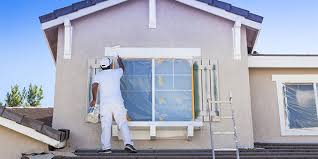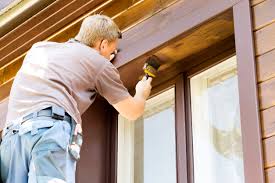GREAT TIPS FOR USING LEFTOVER PAINT
As paint users we should properly manage and if necessary dispose of leftover paint. To minimize clutter and avoid spills or unsafe disposal, it is important to consider ways to limit paint waste.
Always consult your local city or environmental regulatory agency first for guidance on disposal options. Do not pour paint down a drain or into a storm sewer. The dangers of such disposal methods might not be immediately obvious, but improper disposal of paint can pollute the environment and may pose a threat to human health and natural resources.
1. BUY THE RIGHT AMOUNT OF PAINT
Estimate the amount of paint needed by measuring the area to be painted and calculate the gallons to be used. Review the coverage area set forth on the Product Data Sheet of the product you have purchased.
2. STORE PROPERLY
After you finish your project, leftover paint should be sealed and stored in an area that will protect it from damage, freezing and temperatures above 95°F. Make sure that any leftover paint is out of reach of children and pets.
3. SAVING FOR FUTURE USE
Leftover paint can be used for touch up or other creative projects. You can also experiment and mix colors for small projects.
4. DONATE
You can donate leftover paint to a friend, neighbor, school or charitable organization in need of paint. You can use social media to offer it to your friends to find a local person or organization in need of paint. Pass it on!
5. DISPOSAL
a. Latex Paint
If there is not another management option, latex paint can be dried with absorbent material such as cat box filler, shredded newspaper or sawdust. Never throw away leftover liquid paints in your trash. Once it’s dry, dispose of the dried out latex paint as solid waste. Please note that the state of California does not permit the treatment of latex paint waste including air drying. Instead, locate a PaintCare location for recycling your leftover paint or a disposal company.
b. Solvent-based Paint
Solvent-based paints are ignitable and present additional hazards to the environment from the solvents. Save solvent-based paints for a household hazardous waste collection program or contact your local/state government environmental protection agency for guidance on reuse or disposal of unwanted solvent-based paint products. States with PaintCare will collect and properly dispose of leftover Solvent-based paint.

Exterior Paint Selection
Painting the exterior of your house may seem like a job for professionals, but if you’ve got the motivation and some basic knowledge of paints, it’s a job you may want to tackle yourself. It could save you a lot of cash. Latex exterior paints have undergone improvements, and some can be as durable as oil-based.
Below are some tips on selecting exterior paint, from home-improvement specialist James Young. There are two basic types of exterior paint to choose from: oil-based and the more commonly used latex.
- Oil-based paints are very durable and water-resistant. They result in hard finish and are often used by professional painters. Use an oil-based if the surface you are painting has already been painted with oil-based paint.
- Stir oil-based paint frequently, as the oil in these types of paint tend to separate quickly.
- If using oil-based paint, be sure to use a brush or roller specifically designed for use with oil-based paint.
- Latex exterior paints have undergone many improvements, and some can be as durable as oil-based. They are also considerably easier to work with. Be sure, however, that you select an exterior latex for use on the outside of your home, not the same latex used on interior walls.
Tip: Here’s how to determine whether you have acrylic or oil-based paint on your home now. Peel off a large paint-chip. If the chip bends slightly before cracking, it’s probably latex. Oil-paint chips tend to snap easily. If this test doesn’t work for you, take a paint-chip sample to your local paint store or home center and have them test it.
- Latex is easy to apply, dries quickly, is durable and is resistant to the effects of direct sunlight. Cleanup is easy, and just requires water.
- Acrylic latex is the highest-quality latex paint. It will cover just about any building material including masonry and properly primed metal.
- Important: Never put a new coat of latex over an old coat of oil-based paint. It will almost certainly peel.

Diagnose Common Paint Problems:
Poor Prep and Excess Moisture
Take a good look at your house before you start painting. You may have to correct some of the wrongs that the previous painter overlooked in desiring to get the job done fast.
Poorly prepared surface
You may notice the finished coat of paint peeling away from another coat underneath (Figure A). This is the result of painting over a poorly prepped surface. Usually the surface wasn’t cleaned before painting or the primer coat was left too long before the finish coat of paint was applied. You can remedy this situation by firmly scraping away the paint to get at the surface below. Scrape until you get down to a solid surface that may be part bare wood or a sound, previously painted surface. Sand and clean the surface thoroughly, let it dry, and prime all bare wood and spot-prime any small bare spots.
Excess moisture
Sometimes you find paint and primer falling away from the bare wood surface. This is most likely caused by water getting behind the wood or even moisture from the home’s interior. You can’t repaint here unless you stop the source of the moisture migrating through the walls, especially from bathrooms and kitchens. Adding ventilation such as an exhaust fan in the room can frequently help the problem. Many older homes have no vapor barrier, but sometimes applying a vapor barrier paint on the inside will do the trick. If you’re stymied, consult a building contractor to help you solve the problem. Then scrape and sand to remove the loose paint.
Alligatoring
Another common problem is cross-grain cracking, sometimes referred to as “alligatoring.” The source of this problem is usually paint buildup from several layers of oil-based paints. Unfortunately, there’s no magic bullet for this fix. You’ll have to scrape off all the old paint down to bare wood and then sand the surface. Take precautions and gather this paint onto drop cloths or plastic for disposal because it may contain lead. Don”t keep applying layers of paint to areas that don’t need it such as porch ceilings and eaves where the surfaces are protected. Often a good cleaning is all they need.
Other problems
You may find dark mildew spots on the finished coat of paint along shady areas of the house. Buy a special cleaner at paint supply stores to scrub the surface. You can usually stop mildew by increasing exterior airflow in that area, trimming plants close to the house, and channeling water away with gutters and downspouts. If the area is tough to air out, you can get mildewcide additives for your finish coat of paint.
Another problem is chalking, where old paint surfaces get powdery. This is natural for old paints, but you’ll have to power wash or scrub the surface and do some light sanding to remove the chalking before applying paint.

POINTS TO CONSIDER JUST BEFORE EXTERIOR WALL PAINTING
Exteriors are as essential as the interiors and walls aren’t any different. Lots of attention and detailing is performed while planning interior wall painting, exactly the same can also be relevant towards the exteriors which the majority of us frequently ignore. Exterior walls undergo periodic deterioration after being uncovered to heat, dust and water with the year. Here are a couple of options that may be considered:
Exterior wall inspection: Before deciding the color schemes it is important to have an inspection done of the exterior walls. You are able to approach a specialist with this based upon the feedback on the health of the walls after that you can take the next phase.
Cleanup: Knowing the health of your exteriors they come cleaned. Including washing, scrapping from the old paint, elimination of dirt and stains. For wall painting it is best to possess plain surface so the paint spreads evenly around the walls and also the preferred final finish is achieved.
Choice of exterior paints: Choosing the right type of exterior paint is crucial, as painting them frequently is not possible and also you want your walls to look great for some time a minimum of. You will find an array of paints that you can buy varying from gloss to texture based on your financial allowance and requirement. Some exterior paints are dust and algae resistant that will surely benefit your exterior walls.
Colour Selection: Knowing the type of paint that the exterior walls require you are able to choose the colour combinations. You can buy colour schemes like monochromatic, similar or using warm and awesome colours, the options are endless. Selecting top quality paint can also be crucial as you wouldn’t would like your paint to nick off inside a couple of several weeks of their application, making you opt for a renovation once again.
Use of Paint: Once you have finalized the shades and the kind of paint you need to use, the next thing is use of paint. Following a pre and publish wall painting instructions will increase the lengthy existence of the walls. Do purchase a reputed painter even when it is you a bit more. Exterior walls are the initial factor that individuals see you wouldn’t wish to leave a poor impression with regards to you in it through getting a shoddy painting task finished.
Start at the top, and work down, for a great finish.
The final tip I will give you today is to start your painting at the top of the house, not the bottom.This at first seems obvious but with the inexperienced painter may be lacking confidence they often start at the bottom and work up. We know this as quite often the keen DIY painter will start the job, realise he or she can’t finish it and then they contact NEVER PAINT AGAIN to finish the work for them!
Why do you think that TOP decorators are known by that very moniker? TOP!
You must always start at the top, yes on the ladder or the scaffolding, and work downwards, even if only to be bale to have the opportunity to paint over those splashes from your brush or roller whilst painting the top floor exterior? There is a method and a correct way to do almost everything in life, and, provided you take heed to this collection of pretty simple tips, and use the method correctly to paint your house, you shouldn’t have any problems.
And the final take away….